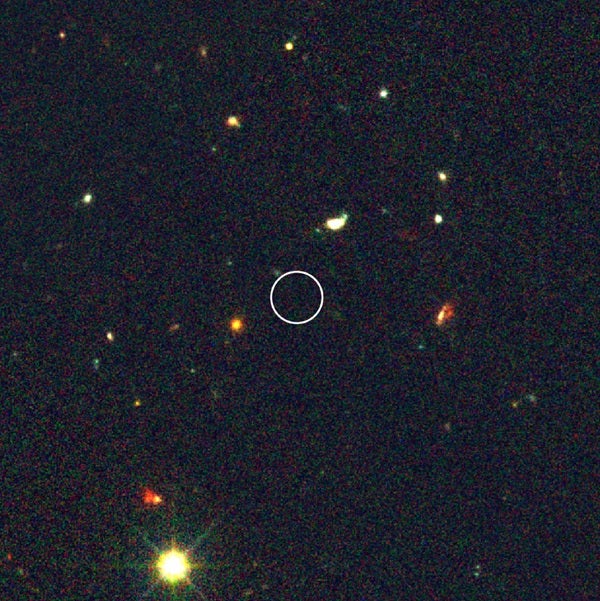A furious rate of star formation discovered in a distant galaxy shows that galaxies in the early universe developed either much faster or in a different way from what astronomers have thought.
“This galaxy is forming stars at an incredible rate,” says Wei-Hao Wang, an astronomer at the National Radio Astronomy Observatory (NRAO) in Socorro, New Mexico. The galaxy, Wang says, is forming the equivalent of 4,000 Suns a year. This is a thousand times more violent than our own Milky Way Galaxy.
The galaxy, called GOODS 850-5, is 12 billion light-years from Earth, and thus is seen as it was only about 1.5 billion years after the Big Bang. Wang and his colleagues observed it using the Smithsonian Astrophysical Observatory’s Submillimeter Array (SMA) on Mauna Kea in Hawaii.
Young stars in the galaxy were enshrouded in dust that was heated by the stars and radiated infrared light strongly. Because of the galaxy’s great distance from Earth, the infrared light waves have been stretched out to submillimeter-length radio waves, which are seen by the SMA. The waves were stretched or “redshifted,” as astronomers say, by the ongoing expansion of the universe.
“This evidence for prolific star formation is hidden by the dust from visible-light telescopes,” Wang explains. The dust, in turn, was formed from heavy elements that had to be built up in the cores of earlier stars. This indicates, Wang says, that significant numbers of stars already had formed, then spewed those heavy elements into interstellar space through supernovae explosions and stellar winds.
“Seeing the radiation from this heated dust revealed star formation we could have found in no other way,” Wang says. Similar dusty galaxies in the early Universe may contain most of the star formation at those times. “This means that future telescopes such as the Atacama Large Millimeter/submillimeter Array (ALMA) can reveal many more such galaxies and give us a much more complete picture of star formation in the early Universe,” he adds.
Lennox Cowie of the University of Hawaii says, “We found out in the last decade that most of the recent star formation in the universe occurs in large dusty galaxies, but we had always expected that early star formation would be dominated by smaller and less obscured galaxies. Now it seems that even at very early times it may be the same big dusty star formers that are the sites of most of the star formation. That’s quite a surprise.”
Astronomers believe that large galaxies originally formed through mergers of smaller objects. Seeing a large galaxy such as GOODS 850-5 forming stars so rapidly at such an early time in the history of the universe is a surprise. “Either the mergers that formed the galaxy happened much faster than we thought or some other process altogether produced the galaxy,” Wang says.










